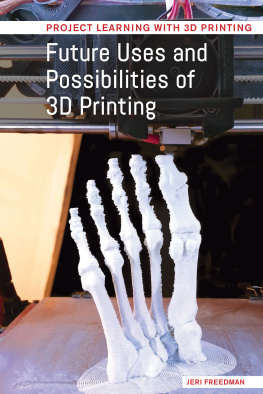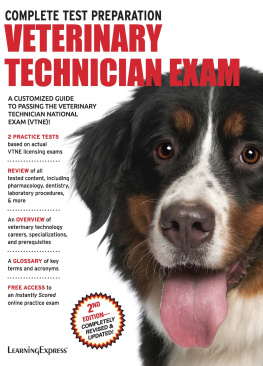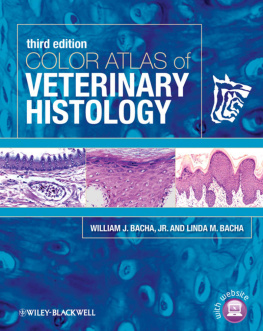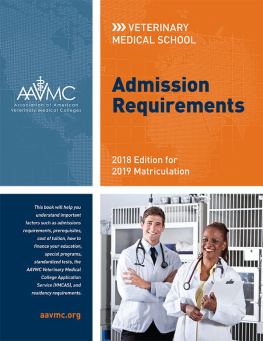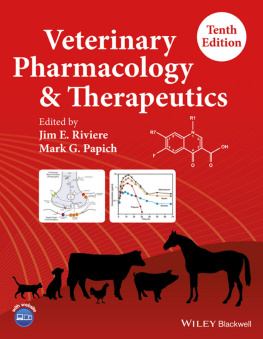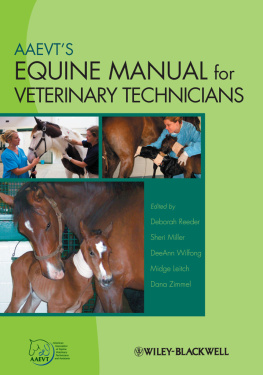Page List

Published in 2019 by The Rosen Publishing Group, Inc.
29 East 21st Street, New York, NY 10010
Copyright 2019 by The Rosen Publishing Group, Inc.
First Edition
All rights reserved. No part of this book may be reproduced in any form without permission in writing from the publisher, except by a reviewer.
Library of Congress Cataloging-in-Publication Data
Names: Freedman, Jeri, author.
Title: Jump-starting a career in veterinary medicine / Jeri Freedman.
Description: First edition. | New York: Rosen YA, 2019. | Series: Health care careers in 2 years | Audience: Grade 712. | Includes bibliographical references and index.
Identifiers: LCCN 2018011828| ISBN 9781508185147 (library bound) | ISBN 9781508185130 (paperback)
Subjects: LCSH: Veterinary medicineVocational guidance.
Classification: LCC SF756.28 .F74 2019 | DDC 636.089023dc23
LC record available at https://lccn.loc.gov/2018011828
Manufactured in the United States of America
CONTENTS
A s she recounts on the Moncton Animal Hospital website, Jessica Moran began the hands-on training part of her veterinary technician program by working at the hospital. In the morning, she assisted with surgeries under the supervision of one of the veterinarians or technicians. Moran cleaned the surgery area and collected the equipment that would be needed for surgery. Her most memorable activity was helping with an emergency cesarean section (C-section) on a dog that was having trouble giving birth. A C-section is surgery to remove a baby from the womb if the mother cannot deliver it through the birth canal. Moran restrained the mother dog so it could be anesthetized, and she got together all the equipment that would be needed to keep her comfortable and warm. When everything was ready, she waited to receive the puppies and if necessary to try to get them breathing. Moran was delighted to help deliver five healthy little puppies.
Many students are interested in working with animals, but they believe that a career in veterinary medicine requires extensive education, which is expensive and therefore out of their reach. There are entry-level jobs in the field, however, that require two years or less of education to get started, and these jobs can be the first step on an excellent career path. Working in the veterinary field involves more than just handling animals. The jobs in the field requiring two years or less of training range from veterinary receptionists and assistants to veterinary technicians. Those who start in such jobs can advance to supervisory or managerial positions, or acquire additional experience or training and move to related animal jobs such as animal health inspector.

Veterinary staff at a zoo give a physical exam to a sedated polar bear. In the veterinary field one can work with exotic as well as domestic animals.
Some animals will need only a routine exam or shots, but many will be injured or ill, which can be upsetting to see. Nonetheless, the veterinary field provides the opportunity to make a difference in the lives of creatures who cannot help themselves. It feels good to help a sick or injured animal get better or to ease its suffering.
Veterinary offices that treat pets such as dogs and cats are not the only places where veterinarians and their assistants and technicians work. The veterinary field also includes large animal practices, which treat farm and ranch animals such as sheep, cows, and horses; mixed animal practices, which treat both small and large animals; zoo and aquarium practices, which care for exotic animals; and animal sanctuaries and preserves for wild animals, as well as other venues. Given the large number of geographic locations and types of facilities in the field, there is a steady demand for employees, which provides job security. The veterinary field offers the opportunity to work in the practitioners choice of indoor and outdoor environments with the types of animals he or she prefers.
The material covered here will describe the specific jobs available, the training and certification required, and practical ways to successfully locate and apply for a job that requires two years or fewer of training.
I n good times and bad, people take care of their animals, on farms and ranches; in public facilities such as zoos, aquariums, and preserves; in shelters; and above all in their homes. Therefore, a position in the veterinary field can provide job security, as well as the fulfillment of making animals lives better and longer. There are veterinary jobs that do not require advanced degrees from prestigious and expensive universities. Moreover, veterinary jobs are available in a wide variety of settings, providing the opportunity to work with the type of animals one prefers, in a facility and location of ones choice. Veterinary staff can work in large, small, or mixed animal practices; in urban or rural locations; at zoos, aquariums, or theme parks; or in wild animal preserves and sanctuaries. These jobs are available to high school graduates with some additional training, short certification courses, or two-year college programs. Such entry-level jobs can be the first step to a more advanced position in the veterinary field, through promotion or by obtaining more education and training. Thus, the veterinary field can provide a secure job with benefits, which also has a solid career path and provides the satisfaction of working with animals.
Veterinary Medicine Today
The number of pets is vast and growing. The American Pet Products Association (APPA) states that in 2015 and 2016 there were 78 million dogs and 85.8 million cats kept as pets in the United States. About one-third of American homes have a cat, and about 44 percent have a dog. According to the American Society for the Prevention of Cruelty to Animals (ASPCA), about 6.5 million dogs and cats enter animal shelters across the United States each year. About 720,000, mostly dogs, are returned to their owners, and another 3.2 million (dogs and cats equally) are adopted.

At Sea World San Diego, a veterinary technician assists in treating a sea turtle that had eaten plastic trash in the ocean, helping to save an endangered animal.
The large number of pets is not the only driving force in the veterinary field. In the past few decades, researchers have made the public aware of the negative effect that human beings are having on the environment in which animals live and the resulting decrease in the numbers of many species in the wild. This circumstance has created an interest in protecting and breeding many wild species so that they do not become extinct. There has been a steady growth in the creation of preserves for animals, and many foundations, zoos, and related institutions have started animal protection and breeding programs. During the same period, there has been a growth in the concern over the way domestic farm animals are treated. The inspection of facilities in which such animals are bred, raised, and housed has increased. These factors provide an opportunity for students who want to work in the veterinary field in positions that dont require a four-year degree.


